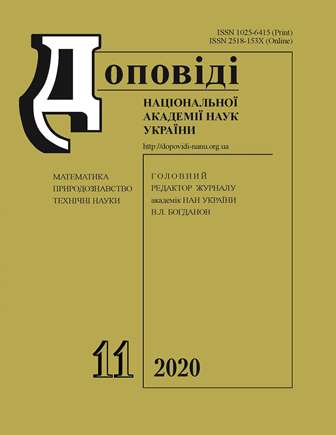Міжфазні явища в композитній системі на основі метилкремнезему та подрібненого гриба Amanita muscaria
DOI:
https://doi.org/10.15407/dopovidi2020.11.061Ключові слова:
гриб Amanita muscaria, композитна система, метилкремнезем, слабоасоційована водаАнотація
Методом 1Н ЯМР спектроскопії встановлено, що композитні системи АМ-1/Amanita характеризуються значно більшою енергією зв’язуваня води, ніж вихідні речовини, що може бути використано для створення лікарських композитів зі збільшеним часом утримування біологічно активних речовин, які входять до складу гриба Amanita muscaria. Визначено, що кількість слабоасоційованої води на порядок менша і спос терігається лише при високих температурах (T >270 K), тоді як у середовищі хлороформу кількість сла боасоційованих форм води зростає і вона реєструється в усьому діапазоні температур. Виявлено, що при температурах понад 273 K у гідрофобно-гідрофільних системах АМ-1/Amanita можливе існування метастабільного твердого стану води
Завантаження
Посилання
Chuiko, A. A., Pogorely, V. K., Barvinchenko, V. N., Lipkovskaya, N. A., Kovtyukhova, N. I. & Turov, V. V. (1999). Physicochemical and clinical substantiation of the effectiveness of drugs of the Phytosil family. Chemistry, physics, and technology of surface, 3, pp. 3-9 (in Russian).
Chuiko, A. A. (Ed.). (2003). Medical chemistry and clinical applications of silica dioxide. Kiev: Naukova Dumka (in Russian).
Turov, V. V., Krupskaya, T. V., Golovan, A. P., Andriyko, L. S. & Kartel, M. T. (2017). Prolonged composite systems based on crushed medicinal plants and nanosilica. Nauka innov., 13, No. 2, pp. 59-67 (in Russian). https://doi.org/10.15407/scin13.02.059
Turov, V. V., Krupskaya, T. V., Golovan, A. P., Andriyko, L. S., Tsapko, M. D., Ostrovskaya, G. V., Kalmyko va, O. A. & Kartel, M. T. (2016). The effect of silica on the hydration of Hibbiscus sabdariffa flowers in neutral and acidic environments. Nanosystems, nanomaterials, nanotechnologies, 14, No. 4, pp. 643-660 (in Russian).
Blitz, J. P. & Gun’ko, V. M. (Eds.). (2006). Surface chemistry in biomedical and environmental science, NATO Science Series II: Mathematics, Physics and Chemistry (vol. 228). Dordrecht: Springer. https://doi.org/10.1007/1-4020-4741-X
Younes, M., Aggett, P., Aguilar, F., Crebelli, R., Dusemund, B., Filipič, M., Frutos, M.J., Galtier, P., Gott, D., Gundert-Remy, U., Kuhnle, G.G., Leblanc, J.-C., Lillegaard, I.T., Moldeus, P., Mortensen, A., Oskarsson, A., Stankovic, I., Waalkens-Berendsen, I., Woutersen, R.A., Wright, M., Boon, P., Chrysafidis, D., Gürtler, R., Mosesso, P., Parent-Massin, D., Tobback, P., Kovalkovicova, N., Rincon, A.M., Tard, A. & Lambré, C. (2018). Re-evaluation of silicon dioxide (E 551) as a food additive. EFSA Journal, 16, No. 1, pp. 1-70. https://doi.org/10.2903/j.efsa.2018.5088
Auner, N. & Weis, J., (Eds.) (2005). Oganosilicon chemistry VI: From molecules to materials. Weinheim: Wiley. https://doi.org/10.1002/9783527618224
Takemoto, T, Nakajima, T. & Sakuma, R. (1964). Isolation of a flycidal constituent ibotenic acid from Amanita muscaria and A. pantherina. J. Pharmacol. Soc. Japan, 84, pp. 1233-1234. https://doi.org/10.1248/yakushi1947.84.12_1186
Michelot, D. & Melendez-Howell, L. M. (2003). Amanita muscaria: chemistry, biology, toxicology and ethnomycology. Mycol. Res., 107, No. 2, pp. 131-146. https://doi.org/10.1017/S0953756203007305
Gun’ko, V. M., Turov, V. V., Pakhlov, E. M., Krupska, T. V., Borysenko, M. V., Kartel, M. T. & Charmas, B. (2018). Water inter actions with hydrophobic versus hydrophilic nanosilica. Langmuir, 34, No. 40, pp. 12145-12153. https://doi.org/10.1021/acs.langmuir.8b03110
Turov, V. V. & Gun’ko, V. M. (2011). Clustered water and ways of using it. Kiev: Naukova Dumka (in Russian).
Gun’ko, V.M. & Turov, V.V. (2013). Nuclear magnetic resonance studies of interfacial phenomena. New York: Taylor & Francis. https://doi.org/10.1201/b14202
Gun’ko, V. M., Turov, V. V., Bogatyrev, V. M., Zarko, V. I., Leboda, R., Goncharuk, E. V., Novza, A. A., Turov, A. V. & Chuiko, A. A. (2005). Unusual properties of water at hydrophilic/hydrophobic interfaces. Adv. Colloid Interface Sci., 118, No. 1-3, pp. 125-172.
Gun’ko, V. M., Turov, V. V., Krupska, T. V., Ruban, A. N., Kazanets, A. I., Leboda, R. & Skubiszewska-Zieba, J. (2013). Interfacial behavior of silicone oils interacting with nanosilica and silica gels. J. Colloid Interface Sci., 394, pp. 467-474. https://doi.org/10.1016/j.jcis.2012.12.026
##submission.downloads##
Опубліковано
Як цитувати
Номер
Розділ
Ліцензія
Авторське право (c) 2023 Доповіді Національної академії наук України

Ця робота ліцензується відповідно до Creative Commons Attribution-NonCommercial 4.0 International License.




